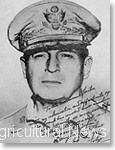GHQ refused proposal of the government
Getting tired of waiting delayed movement of the Japanese side, on December 9, 1945, General Headquarters (GHQ) of the Allied Forces suddenly issued “Memorandum of Understanding on agricultural agrarian reform.” It is called the MacArthur’s “farmers release command”. Next day, in the room of the Committee of Agriculture and Forestry, at the request of Ginichi Kodaira ( 1884 ~ 1976 ), former bureaucrat and former vice president of Chuonogyokai (Central agricultural institution), Hiroo Wada, director of agricultural policy, read the translation of the “Command”.
The memorandum pointed out the current situation of tenant farmers, such as “extreme micro management,” “adverse tenancy conditions,” and with deadline of March 15, it requested to create and submit the plan for the following points;
1) plan of transfer of farmland ownership from absentee landlords to cultivators, 2)System to purchase farmland from the landlord not farming, at reasonable price, 3) system to ensure the purchase by tenant farmers using amortization in accordance with their revenue, 4) system to maintain owner farmer of tenant farmer origin avoiding the return to the tenant farmer.
The air of the Assembly hall changed completely after the command of MacArthur issued. Deliberations over the bill proceeded and the bill was passed in the plenary session on December 15. However, GHQ refused the bill which passed through Japan’s parliament.
Further request for tenant farmers
On March 7, just before the deadline for the Japanese government against the command, GHQ required Senpachi Soejima, Agriculture Minister ( 1881 ~ 1954 ), and Wada, director of agricultural policy, to say, “Holding area of tenant farmland possessed by Resident landlord should be limited to less than 3 ha,” “Farmland transfer from landlord to tenant farmer should be executed through the government agency.” GHQ seemed to have been dissatisfied within from the beginning.
Owing to having no experts of agricultural land, GHQ seemed not to be able to raise precise objection by each time.
◇
Prior to this, in January 1946, Kenzo Matsumura, Agriculture Minister, suddenly became resigned. GHQ issued the command to purge the public officials including 5 ministers. Agriculture Minister Matsumura was also included in its list. Prime minister Shidehara was anger with this unannounced deportation order and allude the mass resignation of cabinet. Cabinet dispatched Foreign minister, Shigeru Yoshida ( 1878 ~ 1967 ),to GHQ, and requested the reduction of purge. But GHQ answered, ” Reduction of purge is impossible because it’s from the Far Eastern Commission of the home country.” Being persuaded by Matsumura, Shidehara stopped his resignation. But 5 ministers including Matsumura resigned.
Tenure of Matsumura was only in 3 months. The successor was Soejima, former food director.
Matsumura wrote some books later. But he didn’t mention anything on agrarian reform in his book, “three generations memoir,” “my resume.” His eldest son, Masanao Matsumura, one of the editors of “Extract of posthumous work of Kenzo Matsumura,” said, “he took deep consideration and sympathy on the landlord hierarchy that paid a lot of sacrifice at that time. ” (“Phantom of the flower, life of Hiroo Wada”).
◇
After the defeat, it was unnatural to maintain senjinogyodan (wartime agriculture group) for the war. But the Japanese government could not afford to amend the nogyodantai law (law of agricultural organization). Then, on October 15, 1945, the government revised the” senjinogyodanrei (Ordinance of wartime agriculture group) ” to the “zenkokunogyokairei (Ordinance of national agricultural institution)” and promulgated on the same day.
Later the government amended nogyodantai law (law of agricultural organization) while being aware of democratization. Its Essence was as follows; 1) To change its consciousness like administrative agency, its activity shall be independent and voluntary, 2) system of council by directors shall be adopted, instead of authority concentration to the president,3) board members shall be elected by election, 4) permission on joining of noji-jikko-kumiai (farming union) and, sanshi-jikko-kumiai (sericulture union).
Despite its pro-democracy compared to senjinogyodan (wartime agriculture group), wartime color of government control was left. After this amendment, until dissolution of nogyokai (agricultural institution), the law had not been revised.
In 1947, the government began to divide the business of nogyokai (agricultural institution) into “business to be remained” and “business not to be remained.” Preparation for the dissolution of nogyokai (agricultural institution) was progressed.
Reference = Tokio Kimura “Kenzo Matsumura, Biography Edition” Sakuradakai, Agricultural Policy Division of Ministry of Agriculture and Forestry “Nogyokaishi (History of agricultural institution)” Ministry of Agriculture and Forestry, Keisuke Otake ” Phantom of the flower, life of Hiroo Wada” Agriculture and Forestry Statistics Publishing Inc., ” History of Nogyokyodokumiai (agricultural cooperatives) system ” Institute of cooperative management
【Booklet】Beginning of agricultural cooperatives <Agrarian reform ④> (February 20, 2016)


